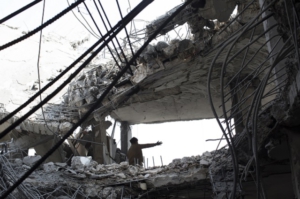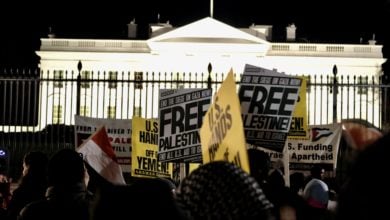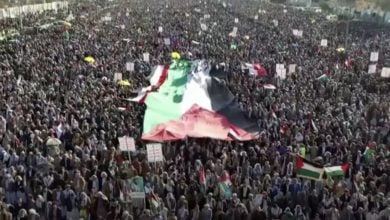
Copyright, Truthout.org. Reprinted with permission. Originally posted April 8.
As Yemen’s population has teetered on the brink of mass starvation in recent months, the United States has played a crucial role in enabling the Saudi strategy responsible for that potential humanitarian catastrophe.
Both the Obama and Trump administrations have prioritized the US’s alliance with the Saudis and their Gulf allies over the lives of hundreds of thousands of Yemenis under imminent threat of starvation.
Although the UN agencies have offered no public estimate of the number of Yemenis who have died of malnutrition-related conditions, it is likely that the figure is much higher than the estimate of 10,000 killed directly by the Saudi-coalition bombing. United Nations agencies have estimated that 462,000 Yemeni children under five years of age are already suffering severe acute malnutrition, putting them at serious risk of death from starvation and malnutrition-related disease.
The Saudi coalition has pursued a war strategy of maximizing pressure on the Houthi resistance by destroying agricultural, health and transportation infrastructure and by choking off access to food and fuel for most of Yemen’s population. The United States has enabled the Saudis to pursue that strategy by refueling the Saudi-led coalition planes bombing Yemen and selling the bombs. Equally important, however, the US has provided the political-diplomatic cover that the Saudis need to carry out this ruthless endeavor without massive international blowback.
The Trump administration has gone even further in supporting the Saudi strategy. Whereas the Obama administration opposed a Saudi-led coalition offensive to regain control over the main port of Hodeidah and the rest of the Red Sea coast, saying it would worsen the humanitarian crisis in Yemen, the Trump administration has clearly given the green light to th Saudis to launch that offensive.
Furthermore the commander of Central Command, Gen. Joseph Votel, has called Yemen a “vital interest” of the United States, arguing that anti-Iranian forces must be in control of it to prevent Iranian threats to the Bab-el-Mandeb Strait. That argument, which conjures a wholly artificial threat to commercial traffic through the Strait, clearly implies active support for the Saudi strategy of recapturing Hodeidah and choking off all access to food for the portion of the Yemeni population under the control of forces loyal to the Houthi and to former President Ali Abdullah Saleh.
But the Obama administration had already acquiesced to a series of moves by the Saudi-led coalition to impose ever-tighter restrictions on the population’s access to food, fuel and medical supplies. A coalition of Houthi rebels and troops loyal to former President Saleh had driven the US- and Saudi-backed Saudi-supported President Abdrabbuh Mansur Hadi from power in 2015, and he ultimately escaped from Aden to Riyadh. The Saudis sought and obtained the support of the Obama administration for a war to reinstall the Hadi government by force. But the Saudi-led coalition advance soon stalled, as the Houthi-Saleh forces demonstrated their mastery of guerrilla tactics. So the Saudis started to rely on a strategy that deprived the population in the Houthi-Saleh area of control of food and fuel.
The administration’s permissive stance toward the Saudi war strategy was evident from the beginning of the war. When the United Nations Security Council was negotiating the April 2015 resolution on Yemen, the original text circulated for discussion included a requirement for “humanitarian pauses” in military operations, but after the Saudis and other coalition members objected vigorously to the language, it was dropped from the final text, according to journalist Sharif Abdel Khouddous.
The Saudi coalition quickly revealed the essence of its strategy in Yemen: to impose extreme hardship on the population in Houthi-controlled governorates. The strategy included not only bombing raids that targeted Yemen’s fragile infrastructure for transportation, food production and medical care, but a naval blockade, ostensibly to prevent any arms from reaching Yemen, but also clearly intended to limit severely the population’s access to foodstuffs and fuel.
Even in peacetime, Yemen is dependent on imports for 90 percent of its staple foods as well as virtually all of its fuel and medical supplies. The consequences of the blockade on the nutrition and health of the civilian population were bound to be devastating.
Oxfam-America humanitarian policy adviser Scott Paul testified to the Tom Lantos Human Rights Commission in January 2017 that, after imposing a naval blockade, the Saudi-led coalition had begun to withhold or delay permission for major commercial and humanitarian vessels to berth in Yemen ports. The coalition held up approval of the delivery of such shipments for weeks, and food often spoiled. “By setting up an arbitrary and onerous regime,” Paul told the Commission, the coalition created a “de facto blockade” preventing food, fuel and medicine from reaching the population.
The climax of the blockade strategy was a series of airstrikes on August 17, 2015, that destroyed all of the cranes used to unload container ships at the main commercial port of Hodeidah, Yemen’s only port capable of receiving such ships. The strikes also destroyed an entire World Food Program warehouse, one of the berths, the port authority warehouse, the port control building and the customs building.
By February 2016, the humanitarian crisis in Yemen as a result of the Saudi blockade was already worse than Syria’s. The UN Security Council had a series of meetings about humanitarian access in both Syria and Yemen, and the members of the Council agreed that resolutions should guarantee humanitarian access — the ability to get food and other humanitarian assistance — to those in need in both countries. But once again, after the Saudis intervened with the United States and its European allies to oppose such a resolution on Yemen, the idea was dropped.
In mid-2016 the Saudis and the Hadi government began planning a much more drastic form of pressure on the population in the Houthi-Saleh-controlled North: eliminating the last institutional barrier to starvation, the Central Bank of Yemen (CBY).
The CBY, which was located in the Houthi-controlled capital, Sanaa, was playing a key role in providing a minimum of liquidity in the society. It was paying the monthly salaries of 1.2 million people on the government payroll, the vast majority of who were still loyal to former president Saleh and are now fighting the Saudi-led coalition forces alongside the Houthis. It was also financing the commercial shipments of food and fuel still arriving at Hodeidah and other ports.
The international financial institutions — with the support of Western governments, including the United States — understood the crucial role of the CBY as an “economic truce” between the warring Yemeni parties that was a necessity to avoid a complete humanitarian catastrophe. But in early July Prime Minister Ahmed Obeid bin Daghr of the Saudi-backed government in Aden explicitly criticized that “economic truce” indicating the intention to bring it to an end. And on August 6, bin Daghr accused the CBY of having used its funds to finance the Houthi-Saleh war effort and called on banks and financial institutions holding large Yemeni foreign reserves to cut off relations with the CBY.
The bank’s governor, Mohammed Awad bin Humam, a highly respected technocrat, wrote a letter to President Hadi denying the charge and proposing that the IMF send a reputable accounting firm to verify his staff’s management of the bank’s accounts. In a press briefing on September 1, IMF press spokesman Gerry Rice endorsed bin Human’s proposal and confirmed that the CBY had played “a crucial role in facilitating minimum levels of import of basic food items, fuel and medicine” over the previous 16 months and had “averted an all-out humanitarian crisis.”
But in mid-September the Hadi government went ahead with its plan to name a new governor of the Central Bank, who would serve in Aden, which was under Saudi coalition control. An unnamed Western diplomat harshly criticized the move to Reuters, calling it an effort to “weaponize the economy by preventing the central bank access to funds abroad.”
The Hadi government promised that the relocated CBY would continue to maintain the bank’s role in providing liquidity and financing imports. In fact, none of Yemen’s civil servants have been paid since the Sanaa-based CBY was cut off from Yemen’s foreign currency reserves abroad, further increasing the number of Yemenis who can no longer purchase food.
Oxfam humanitarian affairs adviser Scott Paul recalled in an interview that Obama administration officials had told him that they had informed the Saudis that they disapproved of the Hadi government’s decision. But the administration said nothing about the move publicly, signaling that it had decided to accept the move. “The idea that the administration should tell the Saudis that Hadi had to back off his replacement of the Central bank governor was never going to fly,” said Paul.
Obama was unwilling to override Saudi policy because of his administration’s firm commitment to the alliance with Saudi Arabia and its Gulf Arab allies. In testimony before the Senate Foreign Relations Committee on March 9, 2017, former Deputy Assistant Secretary of State in the Bureau of Democracy, Human Rights and Labor Dafna Rand recalled that the administration’s policy toward Yemen had reflected “unconditional support for the coalition,” because of what she called “our deep loyalty to our allies” and their aims in regard to Iran.
That “deep loyalty” primarily reflects the overriding US interest in military relations with the Saudis and their Gulf allies. The Saudis and Qataris control the major US bases in the Arab world, such as the naval base in Bahrain — a Saudi client state — and the air and ground bases in Qatar. Moreover the Saudi-led coalition had accounted for $130 billion in US arms sales during the Obama administration alone, generating crucial foreign revenues for major arms contractors and more lucrative future jobs for senior military officers.
So it should come as no surprise that the Pentagon has been the main driver in the US policy of supporting the Saudi strategy of starvation. In August 2016, the Saudis bombed a bridge that the Obama administration had put on a list of targets that were not to be hit, because it was crucial to getting humanitarian goods to population centers in northern Yemen. But the administration did nothing in response.
In fact, the Pentagon openly declared its disinterest in which targets the Saudis and their Gulf allies were actually hitting. A spokesman at the Central Command told journalist Samuel Oakford that the US refueled the coalition’s jets without regard to the target or whether and how it had been vetted, and that if the Saudis decided on more bombing targets, the command would refuel more missions.
The United States shares responsibility with the Saudi-led coalition for the Yemeni deaths from starvation that will result from the Saudi war strategy, because of the coalition’s dependence on US logistical and political-diplomatic support. But the Pentagon and the Central Command are already actively diverting attention from that shared guilt by focusing media attention on what they claim is a new threat from Iran. The result will be to compound the US guilt for mass starvation in Yemen.
Gareth Porter is an independent investigative journalist and historian writing on US national security policy. His latest book, Manufactured Crisis: The Untold Story of the Iran Nuclear Scare, was published in February of 2014. Follow him on Twitter: @GarethPorter.



